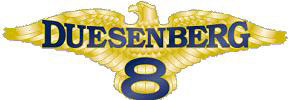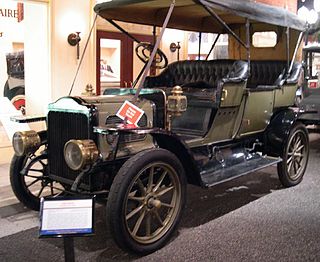
The Standard Steam Car was an American steam car manufactured by the Standard Engineering Company of St Louis, Missouri from 1920 until 1921. [1]

The Standard Steam Car was an American steam car manufactured by the Standard Engineering Company of St Louis, Missouri from 1920 until 1921. [1]
L. L. Scott and E. C. Newcomb developed a steam car claimed to be able to raise a full head of steam within a minute. . Also known as the Scott-Newcomb, it featured a front condenser that resembled a Rolls-Royce shaped radiator and was similar in appearance to the Roamer. The car had a twin-cylinder horizontal steam engine and used kerosene for fuel. The boiler pressure was stated as 600psi. [1] [2]
The Scott-Newcomb Motor Car Company was formed for production but only one touring car is known to have been built; the company may have produced as many as five vehicles before folding. [1] [2]
A 3-page article from 1920 on technical aspects of the Standard Steam Car appears in Floyd Clymer's Historical Motor Scrapbook, Steam Car Edition, published in 1945.
The White Motor Company was an American automobile, truck, bus and agricultural tractor manufacturer from 1900 until 1980. The company also produced bicycles, roller skates, automatic lathes, and sewing machines. Before World War II, the company was based in Cleveland, Ohio. White Diesel Engine Division in Springfield, Ohio, manufactured diesel engine generators, which powered U.S. military equipment and infrastructure, namely Army Nike and Air Force Bomarc launch complexes, and other guided missile installations and proving grounds, sections of SAGE and DEW Line stations, radars, Combat Direction Centers and other ground facilities of the U.S. aerospace defense ring, such as the Texas Towers.
The Locomobile Company of America was a pioneering American automobile manufacturer founded in 1899, and known for its dedication to precision before the assembly-line era. It was one of the earliest car manufacturers in the advent of the automobile age. For the first two years after its founding, the company was located in Watertown, Massachusetts. Production was transferred to Bridgeport, Connecticut, in 1900, where it remained until the company's demise in 1929. The company manufactured affordable, small steam cars until 1903, when production switched entirely to internal combustion-powered luxury automobiles. Locomobile was taken over in 1922 by Durant Motors and eventually went out of business in 1929. All cars ever produced by the original company were always sold under the brand name Locomobile.

The Daimler Company Limited, prior to 1910 The Daimler Motor Company Limited, was an independent British motor vehicle manufacturer founded in London by H. J. Lawson in 1896, which set up its manufacturing base in Coventry. The company bought the right to the use of the Daimler name simultaneously from Gottlieb Daimler and Daimler-Motoren-Gesellschaft of Cannstatt, Germany. After early financial difficulty and a reorganisation of the company in 1904, the Daimler Motor Company was purchased by Birmingham Small Arms Company (BSA) in 1910, which also made cars under its own name before the Second World War. In 1933, BSA bought the Lanchester Motor Company and made it a subsidiary of Daimler Company.

Leyland Motors Limited was a British vehicle manufacturer of lorries, buses and trolleybuses. The company diversified into car manufacturing with its acquisitions of Triumph and Rover in 1960 and 1967, respectively. It gave its name to the British Leyland Motor Corporation, formed when it merged with British Motor Holdings in 1968, to become British Leyland after being nationalised. British Leyland later changed its name to simply BL, then in 1986 to Rover Group.

Duesenberg Automobile and Motors Company, Inc. was an American racing and luxury automobile manufacturer founded in Indianapolis, Indiana, by brothers Frederick and August Duesenberg in 1920. The company is known for popularizing the straight-eight engine and four-wheel hydraulic brakes. A Duesenberg car was the first American car to win the 1921 French Grand Prix and Duesenbergs won the Indianapolis 500 in 1924, 1925, and 1927. Transportation executive Errett Lobban Cord acquired the Duesenberg corporation in 1926. The company was sold and dissolved in 1937.

The Standard Stock title was applied to a variety of Tube stock built between 1923 and 1934, all of which shared the same basic characteristics, but with some detailed differences. This design is also sometimes referred to as 1923 Tube Stock, 1923 Stock, or Pre 1938 Stock. Most of the Standard Stock was built to replace the first generation of "Gate Stock" Tube trains or to provide additional trains for extensions built in the 1920s and early 1930s. Standard Stock cars consisted of motor cars, plus trailer cars and "control trailers". All were equipped with air operated sliding doors, although the guard's door on the earlier trains was a manually operated inward-opening hinged door.

A steam car is a car (automobile) propelled by a steam engine. A steam engine is an external combustion engine (ECE) in which the fuel is combusted outside of the engine, unlike an internal combustion engine (ICE) in which fuel is combusted inside the engine. ECEs have a lower thermal efficiency, but carbon monoxide production is more readily regulated.

Fageol Motors was a United States manufacturer of buses, trucks and farm tractors.

Development of the automobile started in 1672 with the invention of the first steam-powered vehicle, which led to the creation of the first steam-powered automobile capable of human transportation, built by Nicolas-Joseph Cugnot in 1769. Inventors began to branch out at the start of the 19th century, creating the de Rivas engine, one of the first internal combustion engines, and an early electric motor. Samuel Brown later tested the first industrially applied internal combustion engine in 1826.

The Doble steam car was an American steam car maker from 1909 to 1931. Its latter models of steam car, with fast-firing boiler and electric start, were considered the pinnacle of steam car development. The term "Doble steam car" comprises any of several makes of steam-powered automobile in the early 20th century, including Doble Detroit, Doble Steam Car, and Doble Automobile, severally called a "Doble" because of their founding by Abner Doble.
The railways of New South Wales, Australia, use a large variety of passenger and freight rolling stock. The first railway in Sydney was opened in 1855 between Sydney and Granville, now a suburb of Sydney but then a major agricultural centre. The railway formed the basis of the New South Wales Government Railways. Passenger and freight services were operated from the beginning. By 1880, there was a half hourly service to Homebush.

Straker-Squire was a British automobile manufacturer based in Bristol, and later Edmonton in North London.

The Rauch & Lang Carriage Company was an American electric automobile manufactured in Cleveland, Ohio, from 1905 to 1920 and Chicopee Falls, Massachusetts, from 1920-1932.

A Darracq and Company Limited owned a French manufacturer of motor vehicles and aero engines in Suresnes, near Paris. The French enterprise, known at first as A. Darracq et Cie, was founded in 1896 by Alexandre Darracq after he sold his Gladiator Bicycle business. In 1902, it took effect in 1903, he sold his new business to a privately held English company named A Darracq and Company Limited, taking a substantial shareholding and a directorship himself.

The Commonwealth Motors Corporation was a luxury auto company that produced cars from 1917 to 1922. The company was founded in Chicago as Partin-Palmer company in 1913, but in 1915 got into financial trouble. So, in 1917, the name was changed to Commonwealth, and production was moved to Joliet, Illinois.

Carl Breer was an American automotive industry engineer. Along with Fred M. Zeder and Owen Skelton, he was one of the core engineering people that formed the present day Chrysler Corporation. He was the design engineer behind the Chrysler Airflow automobile.

Departmental locomotives on the London Underground consist of vehicles of a number of types which are used for engineering purposes. These include battery locomotives, diesel locomotives, electric locomotives, sleet locomotives, pilot motor cars and ballast motor cars. Details of the first four types are covered elsewhere. Pilot motor cars and ballast motor cars are generally vehicles which have been withdrawn from passenger service, but continue to be used by the engineering department. Pilot motor cars are used to move other vehicles around the system, while ballast motor cars are used to haul ballast trains and engineering trains.